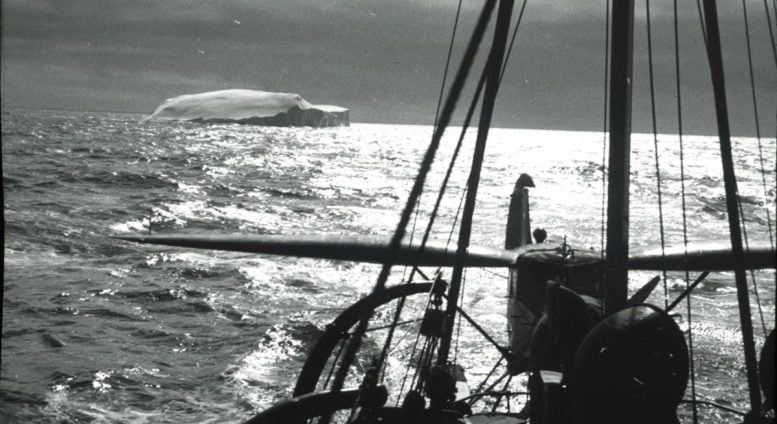
Researchers at the University of Copenhagen used aerial photographs taken in 1937 to analyze the stability and growth of ice in East Antarctica, revealing that despite some signs of thinning, the ice has remained largely stable for nearly a century, reinforcing predictions of sea level rise. Image source: Norwegian Polar Institute in Tromsø
A study using forgotten aerial photographs of whalers from 1937 showed that the ice in East Antarctica was stable and even growing, despite some early signs of thinning.
Extreme weather, melting glaciers, and rising sea levels are all indicators that the world’s climate and glaciers are in critical condition. However, a new study conducted by the Department of Earth Sciences and Natural Resource Management at the University of Copenhagen has revealed a positive anomaly.
Using hundreds of old aerial photographs dating back to 1937, combined with modern computer technology, researchers were able to track the evolution of glaciers in East Antarctica. This area, which extends over nearly 2,000 kilometers of coastline, contains as much ice as the entire Greenland ice sheet. By comparing historical aerial images with modern satellite data, the researchers identified glacier movement and changes in size, revealing that the ice has not only remained stable, but also grown slightly over the past 85 years, in part due to increased snowfall.
“We constantly hear about climate change and new melting records, so it is refreshing to observe a region of glaciers that has remained stable for almost a century,” says doctoral student Mads Domgaard, first author of the study.
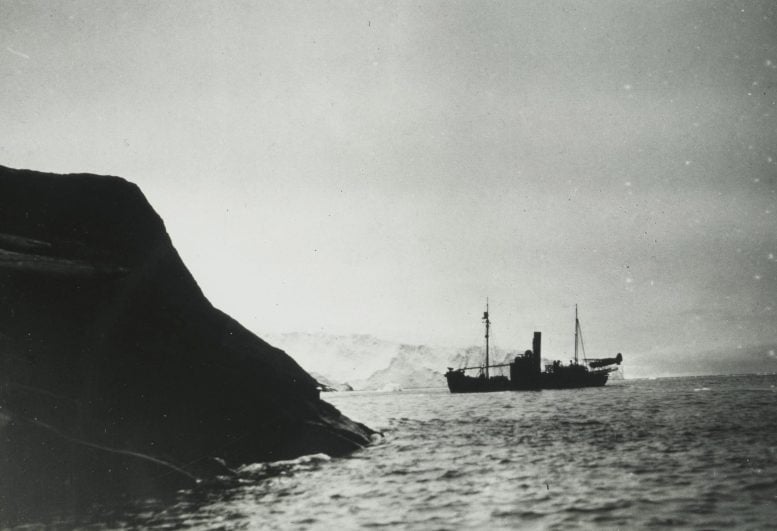
The whaling ship Firern, with a Stinson Reliant on board, near the Klarius Mikkelsen Fjell in Lars Christensen Land, East Antarctica. Norwegian Polar Institute Credit
Early signs of change
Despite the overall stability, the research also reveals the first signs of changes in the sea ice surrounding the glaciers, suggesting that these stable glaciers in East Antarctica may be shrinking in the future.
“Our results also indicate weak sea ice conditions, making floating tongues of ice in glaciers more vulnerable and unable to grow as large as seen in early aerial photographs from 1937. We know from other parts of Antarctica that the ocean plays a role.” “Very important.” “The massive and increasing melting we see in West Antarctica, for example,” says Domgaard.
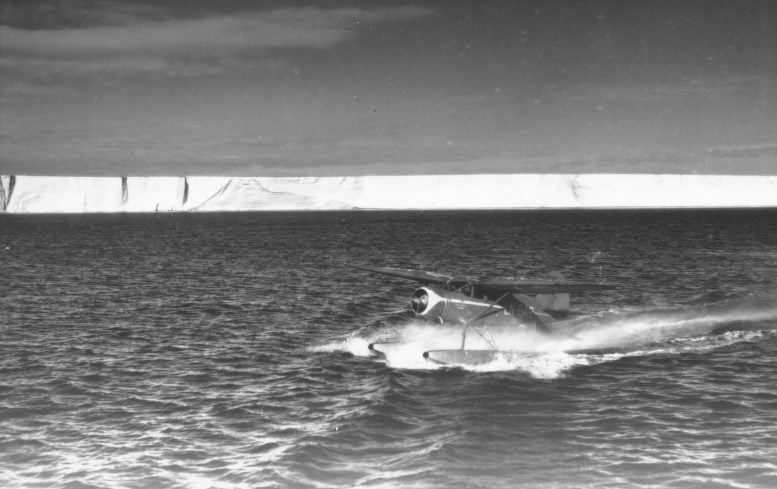
A Stinson Reliant poton (call sign LN-BAR) was used for aerial photography. The aircraft has a range of about 1,200 kilometers and a Zeiss automatic camera is installed in the floor of the aircraft. Credit: Norwegian Polar Institute
Hidden from the Nazis
Most of the photographs used in the study were taken during a 1937 expedition organized and paid for by Norwegian whaler Lars Christensen. The mission aimed to produce the first maps of this part of East Antarctica, but the maps were never published due to the German invasion of Norway. Since then, the images have been stored at the Norwegian Polar Institute in Tromsø and forgotten.
When researchers from the University of Copenhagen read about the expedition, they realized that valuable images were likely hidden in archives in Norway. They traveled to Tromsø and reviewed all 2,200 photographs taken during the expedition. They supplemented the Norwegian aerial photographs with images of the same glaciers from Australian surveys conducted between 1950 and 1974.
“By comparing historical aerial images with modern satellite data, we have gained important knowledge about glaciers that we would not have otherwise had,” says Associate Professor Anders Björk from the University of Copenhagen, who leads the group working on the historical images. “These ancient photographs can be used to generate new research results nearly 100 years after they were taken.”
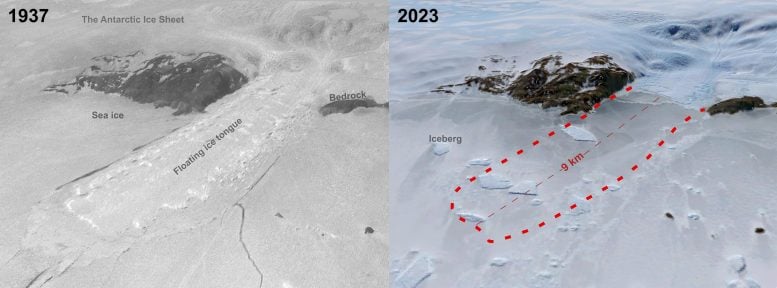
Honnörbrygga Glacier in Lützow-Holm Bay in 1937 compared to a modern Landsat satellite image from 2023. The 9-kilometre-long floating ice tongue seen in the 1937 image disappeared in the late 1950s and has not grown again due to the weakening Sea ice. Source: Mads Domgaard / Norwegian Polar Institute
Possibility of rapid sea level rise
The Antarctic ice sheet is receiving increasing attention from researchers because of the potential for sea levels to rise very quickly. Unlike Greenland, very little was known about Antarctica’s glaciers until the 1990s, when the first good satellite observations became available.
“Early observations of glaciers are very valuable because they give us unique insight into how ice evolves through varying climate and whether current changes in ice go beyond glaciers’ natural cycle of advance and retreat,” explains Domgaard.

Ingrid Christensen, wife of Lars Christensen, participated in numerous expeditions to Antarctica and is considered the first woman to set foot on Antarctica. Here she is seen in a 1937 Stinson plane preparing to drop the Norwegian flag over the land area of East Antarctica. Credit: Norwegian Polar Institute
Enhancing predictive models
According to the researcher, robust long-term data is essential to produce accurate predictions of future developments of glaciers and sea level rise, and this study provides new insights into a vast region of East Antarctica.
“Long glacier series improve our ability to make more accurate models of future glacial changes, as models are trained on historical observations,” Björk concludes.
The results were recently published in Nature Communicationsthe result of a collaborative effort involving researchers from the University of Copenhagen, the Norwegian Polar Institute, the Arctic University in Norway, and the Institute of Environmental Earth Sciences in France.
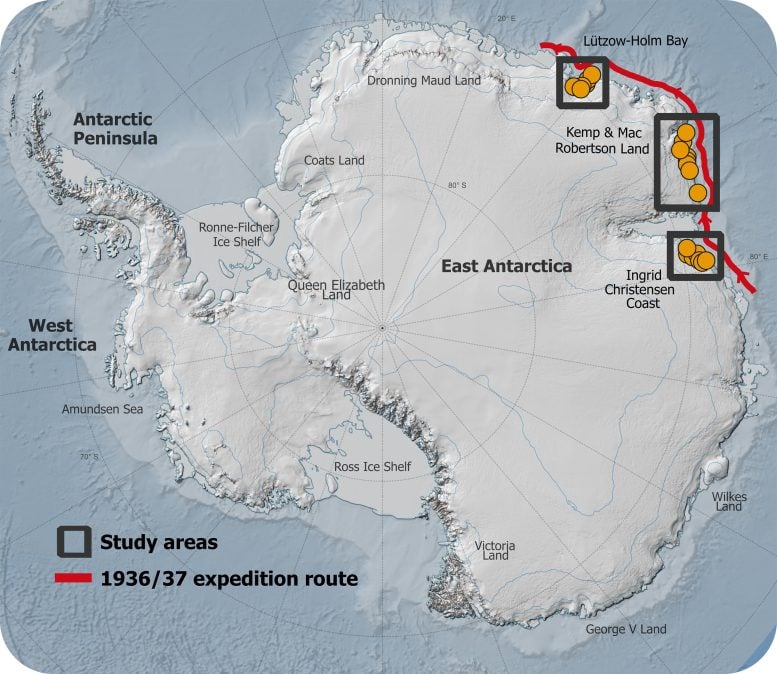
A general map of the mission’s route in 1936/1937 and the areas surveyed by researchers. Credit: Mads Domgaard
More about the study
- Of 2,200 photographs taken from seaplanes in 1937, 130 were selected for analysis.
- The researchers combined historical images with modern satellite data to create 3D reconstructions of the glaciers.
- The Norwegian aerial photographs were supplemented by 165 aerial photographs of the same glaciers from Australian surveys conducted between 1950 and 1974. This allowed the researchers to examine the evolution of glaciers over different periods and calculate historical ice flow velocities for selected glaciers.
- Compared with recent data, ice flow speeds have not changed. While some glaciers have diminished over shorter average periods of 10 to 20 years, they have remained stable or grown slightly over the long term, suggesting a balanced system.
Reference: “Early flight images reveal 85 years of glacier growth and stabilization in East Antarctica” by Mads Domgaard, Anders Schumaker, Elisabeth Isaacson, Roman Milan, Flora Huiban, Amaury Deheke, Amanda Fleischer, Geir Möhholdt, and Jonas K. Andersen and Anders. a. Björk, May 25, 2024, Nature Communications.
doi: 10.1038/s41467-024-48886-x
The research was funded by the Velum Foundation.




/cdn.vox-cdn.com/uploads/chorus_asset/file/25550621/voultar_snes2.jpg)

More Stories
Watch a Massive X-Class Solar Explosion From a Sunspot Facing Earth (Video)
New Study Challenges Mantle Oxidation Theory
The theory says that complex life on Earth may be much older than previously thought.